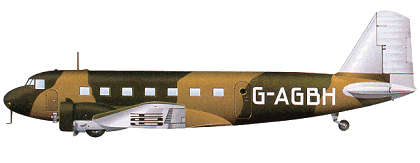| Informed 1, e-mail, 09.11.2009 04:01 The Douglas DC-1 was the first model of the famous United States DC (Douglas Commercial) commercial transport aircraft series. Although only one example of the DC-1 was produced, the design was the basis for the DC-2 and DC-3, the starting point of one of the most successful aircraft designs in history.
Development of the DC-1 can be traced back to the 1931 crash of TWA Flight 599, due to the failure of a wooden strut, which in turn was caused by water which had over time seeped between the layers of the wood laminate and dissolved the glue holding the layers together.
Following the accident, the Civil Aeronautics Board ruled passenger aircraft could no longer contain wings or structural members (such as struts and spars) made of wood. Boeing developed an answer, the 247, but their production capacity was limited and they could only supply their primary contract, United Airlines. TWA wanted a similar aircraft, and asked four manufacturers to bid for construction of a three-engine, 12-seat aircraft to meet the specifications stipulated by the CAB:
All metal wings and structural members
Retractable landing gear
Capable of remaining in flight, even if one engine failed.
Donald Douglas was initially reluctant to participate in the invitation from TWA. He doubted there would be a market for 100 aircraft, the number of sales necessary to cover development costs. Nevertheless, he submitted a design consisting of an all-metal, low-wing, twin-engine aircraft seating 12 passengers, a crew of two and a flight attendant. The aircraft exceeded the specifications of TWA even with two engines. It was insulated against noise, heated, and fully capable of both flying and performing a controlled takeoff or landing on one engine.
Only one aircraft was produced, the prototype. It made its maiden flight on July 1, 1933 [1], flown by Carl Cover, and was given the model name DC-1. During a half year of testing, it performed more than 200 test flights and demonstrated its superiority versus the most used airliners at that time, the Ford and Fokker Trimotors. It was flown across the United States, making the journey in a record time of 13 hours 5 minutes.
TWA accepted the model with a few modifications (mainly increasing seating to 14 passengers and adding more powerful engines) and ordered 20 aircraft. The production model was called the Douglas DC-2.
The DC-1 was sold to Lord Forbes in the United Kingdom in May 1938, who operated it for a few months before selling it in France in October 1938. It was then sold to Líneas Aéreas Postales Españolas (L.A.P.E.) in Spain in November 1938. Later operated by Iberia Airlines from July 1939 with the name Negron it force-landed at Malaga, Spain in December 1940 and was damaged beyond repair.[2]
General characteristics
Crew: 2 pilots and flight attendant
Capacity: 12 passengers
Length: 60 ft (18,28 m)
Wingspan: 56 ft (17,06 m)
Height: 16 ft 10 in (4.88 m)
Empty weight: 11,400 lb (5,171 kg)
Max takeoff weight: 17,500 lb (7,938 kg)
Powerplant: 2× Wright Cyclone SGR-1820F 9-cylinder radial engines, 710 hp (522 kW) each
Maximum speed: 232 mph (373 km /h)
Cruise speed: 186 mph (300 km /h)
Range: 930 mi (810 nm, 1,500 km)
Service ceiling: 23,000 ft (7,010 m) reply |













